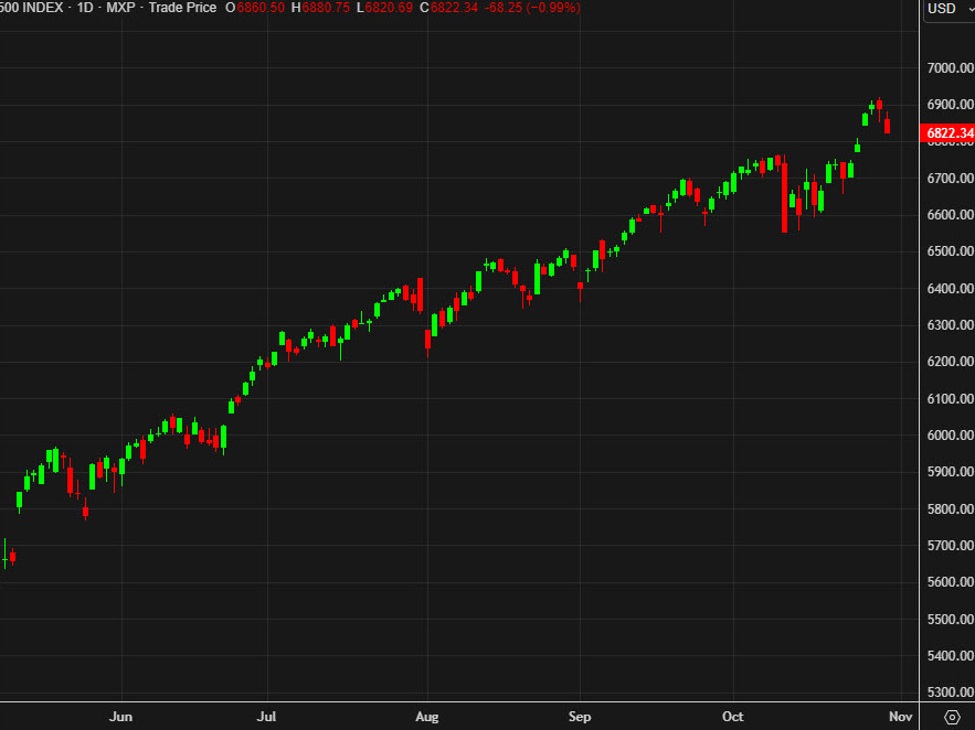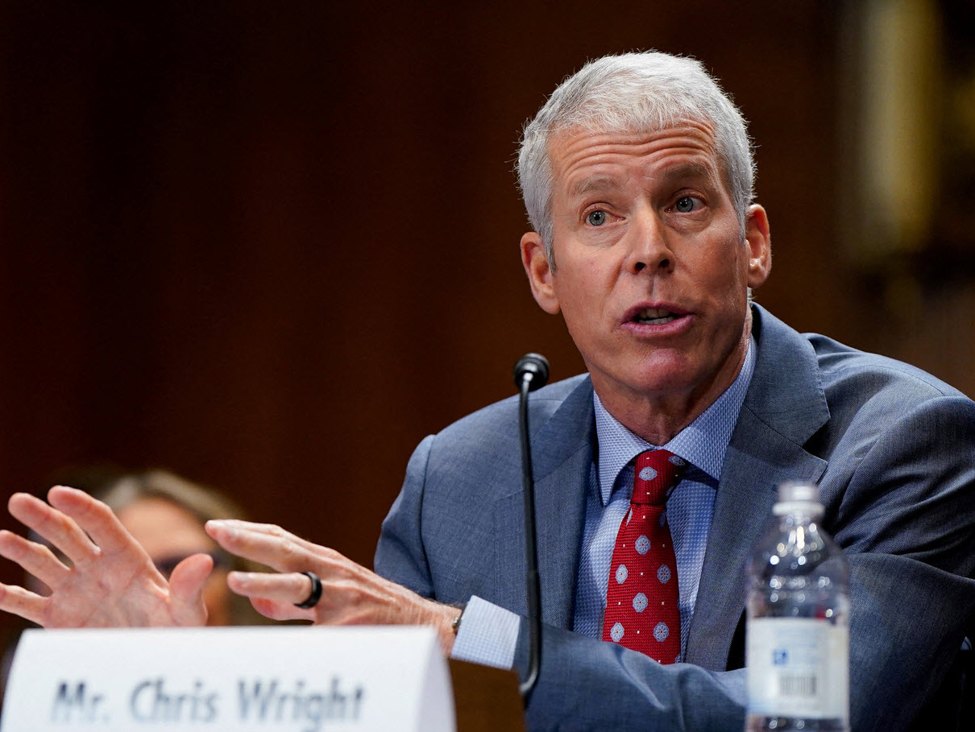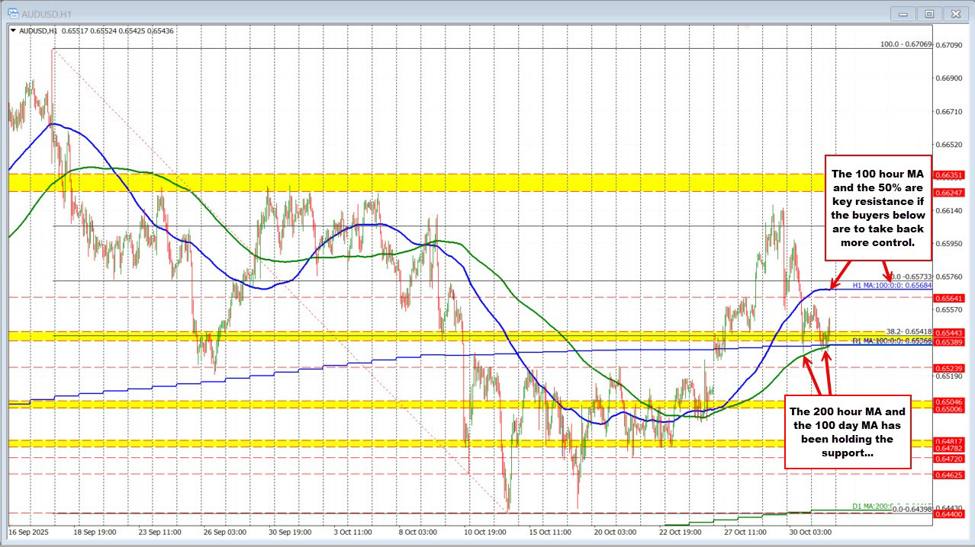I have been writing about the k-shaped economy this week but we’re increasingly in a k-shaped stock market. The S&P 500 hit a record this week but yesterday, 9% of stocks in the S&P 500 hit a 52-week low.This is a market that’s being carried by some Mag7 names and the AI trade.AbbVie (ABBV) — Fell 1.6% after another weak quarter in its aesthetics segment despite strength in new anti-inflammatory drugs.Amazon (AMZN) — Up 13.5% on strong earnings ($1.95/sh vs. $1.57 est.) and $180.2B in revenue, beating expectations.Apple (AAPL) — Added 2% after topping Q3 earnings and revenue forecasts and guiding for a strong holiday quarter.Brighthouse Financial (BHF) — Soared 24% after FT said Aquarian Holdings is in talks to buy and take the insurer private.Charter Communications (CHTR) — Fell 5% as EBITDA missed ($5.56B vs. $5.61B est.), offset by slightly better revenue.Chevron (CVX) — Gained 1.5% as profits from the $53B Hess acquisition lifted oil output and cash flow.Cboe Global Markets (CBOE) — Up 1% after beating Q3 estimates and announcing a business realignment and asset sales.Dexcom (DXCM) — Dropped 12% after management warned 2026 revenue growth could trail Wall Street’s 15% forecast.Exxon Mobil (XOM) — Shares down 0.8% despite beating Wall Street expectations for a sixth straight quarter, driven by new oil production in Guyana.Intuitive Machines (LUNR) — Up 5% after an $8.2M Air Force contract extension for nuclear spacecraft power systems.Netflix (NFLX) — Up 1.3% premarket; approved a 10-for-1 stock split and reportedly exploring a bid for Warner Bros. Discovery assets.Newell Brands (NWL) — Sank 18% on weak earnings and guidance cut; now expects EPS of $0.56–$0.60 and revenue down 4.5–5%.Nvidia (NVDA) — Flat; CEO Jensen Huang said he still hopes to sell Blackwell chips to China but has no near-term plans.Ramaco Resources (METC) — Up 13% after signing a deal with the U.S. Energy Department to advance rare earths mining.Strategy (MSTR) — Climbed 6% after revenue ($128.7M) topped estimates, helped by bitcoin exposure and software growth.Twilio (TWLO) — Surged 11% as Q3 results beat estimates ($1.25/sh on $1.3B revenue vs. $1.08/sh est.).Western Digital (WDC) — Gained 9% after earnings ($1.78/sh on $2.82B revenue) beat expectations. This article was written by Adam Button at investinglive.com. 🔗 Read Full Article 💡 DMK Insight The S&P 500’s record high masks a troubling trend: 9% of its stocks just hit 52-week lows. This divergence highlights a k-shaped market where a handful of mega-cap stocks, often referred to as the ‘Magnificent Seven,’ are driving the index higher while broader market participation weakens. For traders, this could signal a potential correction as the underlying weakness in the majority of stocks may lead to increased volatility. If you’re holding positions in the broader market, now’s the time to reassess your exposure. Watch for key support levels in the S&P 500; if it breaks below recent highs, it could trigger a broader sell-off. On the flip side, focusing on the strong performers could yield short-term gains, but be cautious of over-reliance on a few stocks. Keep an eye on sector rotation and consider diversifying into undervalued stocks that may rebound as the market stabilizes. Watch for earnings reports and economic indicators that could influence market sentiment in the coming weeks. 📮 Takeaway Monitor the S&P 500 closely; a break below recent highs could signal a broader market correction amid underlying weakness.
The USDCAD is trading to new highs for the week. The sellers became buyers after the Fed
The USDCAD is trading at new highs as the week draws to a close — a sharp turnaround from the early-week tone, when sellers were in control through Tuesday and Wednesday. That changed after the Fed’s rate cut, as Chair Powell emphasized that the Fed is not on a pre-set path to ease again in December. The comments triggered a rebound in the dollar, pushing USDCAD higher.Technically, the pair reclaimed the broken 200-day moving average at 1.3927, retested it successfully yesterday, and then extended higher. The price also broke above the 200-hour MA at 1.39855 after briefly closing below it on Thursday while holding the 100-hour MA support near 1.3967. Today’s break above the 200-hour MA drew in fresh buyers and drove the pair to new weekly highs.The next upside target comes at last Friday’s high of 1.4038. A sustained move above that level would open the door toward the October swing area between 1.4060–1.4067, followed by the monthly high near 1.4079.On the downside, the 1.4000 area remains the near-term risk level, with support layered at 1.4004 (swing level) and the psychological round number itself.Bottom line: Momentum has shifted firmly to the buyers heading into the weekend, with the trend favoring further upside while 1.4000 holds as support. This article was written by Greg Michalowski at investinglive.com. 🔗 Read Full Article 💡 DMK Insight The USDCAD’s surge to new highs signals a shift in market sentiment following the Fed’s rate cut. This turnaround highlights the impact of monetary policy on currency pairs, especially as Powell’s comments suggest a more flexible approach to future rate decisions. Traders should note that the recent highs could attract profit-taking, especially if resistance levels are tested. The volatility in this pair is likely to affect correlated assets like CAD-denominated commodities, particularly oil, which has a strong influence on the Canadian dollar. Keep an eye on the 1.40 level as a potential pivot point; a break above could lead to further gains, while a rejection might signal a pullback. The market’s reaction in the coming days will be crucial, especially as we head into the end of the month, which often brings increased volatility and positioning adjustments from institutional players. 📮 Takeaway Watch for USDCAD’s performance around the 1.40 level; a break could signal further upside, while a rejection might lead to a pullback.
Trump appears to be leveraging the fall in oil prices
If Trump wanted Russia to lose the war in Ukraine or regime change in Iran/Venezuela, what would be his first move?The wise move would be to pull on whatever levers possible to get oil prices down in order to minimize a spike later. You could do that by leaning on Saudi Arabia and allies in OPEC to open up the taps.That appears to be what’s happened as OPEC has pumped (at least officially) well beyond what anyone expected when Trump rolled into office. That has WTI down to $61 and a broad belief that the crude market will be oversupplied in the year ahead.But what’s Part 2? Today we’re learning that Trump is preparing to attack military installations within Venezuela. I happen to think the 700-900 mbpd of Venezuelan exports (a third of that is controlled by Chevron) is insignificant and not at risk but it may speak to Trump’s strategy. The bigger levers are Iran — which has already been struck — and Russia with its 12 mbpd of production.TotalEnergies CEO is out with a notable comment today.”I am more bullish […] because I begin to realize that these sanctions will have a real impact in this market,” he said. “I think the market is underestimating what it means.”I’m cautious on oil at the moment because OPEC is going to add even more barrels this weekend but a real geopolitical shock could be a gamechanger and at some point in 2026, crude might be the best trade out there. This article was written by Adam Button at investinglive.com. 🔗 Read Full Article
US energy secretary: Goal is to bring Canada-US back together for trade talks
This is the first US cabinet official that’s talked about re-starting US-Canada trade talks. They fell apart last week after Trump had a tantrum about a Ronald Reagan ad.The market almost entirely shrugged off the breakdown and Trump’s threat of fresh 10% tariffs on Canada, so this isn’t a surprise but there is some uncertainty on when trade talks might restart or conclude. There is a fairly narrow window now with US Thanksgiving and then Christmas coming. This article was written by Adam Button at investinglive.com. 🔗 Read Full Article
EURUSD Technicals: EURUSD breaks to a new month low as seller take more control
The EURUSD sellers are pressing their advantage with a break below the 1.1541–1.1546 support area — a zone that now turns into near-term resistance and defines risk for shorts.On the downside, the pair is testing an older swing area from June through August between 1.1518 and 1.1529, with the low so far reaching 1.1522. A move below 1.1518 would confirm a deeper bearish extension and keep sellers firmly in control.Bottom line: Sellers have the upper hand, and as long as the price stays below 1.1546, the path of least resistance remains to the downside. This article was written by Greg Michalowski at investinglive.com. 🔗 Read Full Article 💡 DMK Insight The EURUSD just broke below key support, and here’s why that matters: Sellers are gaining momentum after breaking the 1.1541–1.1546 support zone, which now flips to resistance. This shift is crucial for short positions, as it sets the risk level for traders looking to capitalize on further declines. The next critical area to watch is the swing zone between 1.1518 and 1.1529, which could act as a potential bounce point or a further breakdown if breached. If the pair fails to hold above this range, we could see a cascade effect, pushing the EURUSD lower and potentially impacting correlated assets like the DXY index, which measures the dollar’s strength. But don’t overlook the possibility of a short squeeze if the price rebounds. Traders should monitor the 1.1546 level closely; a failure to reclaim this could solidify bearish sentiment. Watch for volatility around economic data releases that could further influence the euro’s movement against the dollar in the coming sessions. 📮 Takeaway Keep an eye on the 1.1518–1.1529 zone; a break below could trigger further selling pressure in EURUSD.
Consumer cyclical rocket: Amazon leads a bullish charge while Google faces headwinds
Sector OverviewToday’s stock market heatmap reveals a compelling narrative unfolding across sectors, with the consumer cyclical sector skyrocketing, led by an impressive surge from Amazon (AMZN), up a remarkable 10.38%. This rally highlights a robust recovery in retail demand and investor optimism in online shopping trends. Tesla (TSLA) also shone brightly, rising 3.36%, signaling positive sentiment in the auto manufacturing space.Conversely, the technology sector painted a more mixed picture. While Nvidia (NVDA) saw a positive climb of 1.36% within the semiconductor group, indicating investor confidence in its future prospects, giants like Microsoft (MSFT) and Google (GOOG) fell by 1.46% and 1.13% respectively, pointing to sector rotation and profit-taking hitting these heavyweights.Market Mood and TrendsThe broader market sentiment remains cautious, with investors juggling between chasing high-growth opportunities in consumer cyclicals and securing profit in established tech stalwarts. The mixed performance suggests an underlying anxiety about inflationary pressures and interest rate implications, driving a selective enthusiasm.Healthcare’s ABBV dropped significantly by 4.22%, potentially due to sector rotation or disappointing news impacting medical stocks.Strategic RecommendationsIn light of today’s trends, investors may consider bolstering their portfolios with consumer cyclical stocks, which show promising growth potential amid shifting consumer behaviors. Paying attention to retail giants and auto manufacturers could offer rewarding opportunities.Meanwhile, it’s advisable to adopt a wary stance on tech stocks like Google and Microsoft, where current weakness could either be a temporary setback or a signal to recalibrate exposure. Keeping an eye on upcoming economic data and industry reports will be crucial for timely investment decisions.Investors should explore strategies to protect against potential tech volatility by diversifying across resilient sectors such as consumer cyclicals or even cautiously eyeing financials, where some banks like JPMorgan (JPM) showed moderate gains.For those seeking in-depth analyses and daily market updates, visit InvestingLive.com to stay ahead of market curves and enhance your investment strategies. This article was written by Itai Levitan at investinglive.com. 🔗 Read Full Article 💡 DMK Insight Amazon’s 10.38% surge is more than just a stock move—it’s a signal of shifting consumer behavior. This rally in the consumer cyclical sector suggests a rebound in retail demand, which could have ripple effects across related sectors like tech and logistics. If this trend continues, traders should watch for potential breakouts in other retail stocks and related ETFs. Key levels to monitor include Amazon’s recent highs, which could act as resistance if the momentum falters. On the flip side, if this surge is driven by short-term sentiment rather than sustainable growth, we might see a pullback, especially if broader economic indicators show weakness. Keep an eye on upcoming earnings reports and consumer sentiment data, as these could provide critical context for the market’s next moves. 📮 Takeaway Watch Amazon’s resistance levels closely; a sustained rally could pull other retail stocks up, but a reversal might signal broader market weakness.
Why the Fed's Schmid is right to cite financial conditions as a reason to pause rate cuts
A surprise in this week’s Fed decision was a hawkish dissent from Kansas City Fed President Schmid, who didn’t want to hike rates. In his published comments today regarding the dissent, one of the things he highlighted was the tailwind from ‘financial conditions’. That’s a code phrase from the Fed that mostly means ‘the stock market’ and what he’s saying is that rising stock prices will boost growth, or at least signal that the Fed isn’t leaning too hard on the brakes.An index published by Goldman Sachs shows that broader financial conditions are currently the most accommodative they have been in three-and-a-half years and that they’ve only been looser twice since 1990 (ex pandemic).National Bank notes that in other loose periods in 1999 and 2018, the Fed was tightening and now it’s doing the opposite. A model developed by the Fed suggests that, at their current level, financial conditions could add as much as 1% to growth over the next twelve months. That’s all well and good, but when you add to these figures the anticipated effect of the three other elements covered in recent days (AI investment, the wealth effect, and fiscal policy), there is reason to fear that the economy could overheat in 2026. (Keep in mind, we haven’t even mentioned the supply shock that could be caused by tariffs and the reduction in the labour supply due to stricter immigration policies.) This is certainly a risk that is increasingly on our minds. This article was written by Adam Button at investinglive.com. 🔗 Read Full Article 💡 DMK Insight The Fed’s hawkish dissent is a signal traders can’t ignore right now. Kansas City Fed President Schmid’s reluctance to hike rates indicates a potential shift in the Fed’s approach, especially as he points to favorable ‘financial conditions.’ This could suggest that the Fed is weighing the economic landscape more cautiously, which might lead to a more dovish stance in future meetings. For traders, this is crucial; it could impact interest rate-sensitive assets like bonds and equities. If financial conditions remain loose, we might see a rally in risk assets, but be wary of volatility as market participants react to any shifts in Fed language. On the flip side, if the market misinterprets this dissent as a sign of weakness, we could see a sell-off in equities, especially if inflation data comes in hotter than expected. Keep an eye on the upcoming economic indicators and how they align with Fed commentary. Watch for key levels in the S&P 500 around recent highs, as a break could signal a shift in sentiment. The next FOMC meeting will be pivotal, so stay tuned for any hints on rate direction. 📮 Takeaway Watch for the S&P 500’s reaction to upcoming economic data; a break above recent highs could signal a bullish trend as the Fed’s stance evolves.
AUDUSD Technicals.The key levels "in play" are defined for the AUDUSD. Watch and find out.
The AUDUSD moved higher early in the week, but the Fed’s less-dovish tone turned the tide — sending the AUD lower and the USD broadly higher. Stocks slipped and yields rose in response to the more hawkish message from Chair Powell. That helped the push lower as well. Still, the downside move has found support near the 200-hour and 100-day moving averages, both converging around 0.65366. That confluence gives traders a clear risk-defining level, and buyers have stepped in to defend it. With risk contained below, “buyers are in play.”The next upside targets sit first at the day’s high, and more importantly, the 100-hour MA at 0.65684 — a level broken to the downside yesterday and now acting as a key barrier. A move above it would shift momentum back in favor of the bulls.If buyers can’t hold the line and price slips below the converged MAs, however, the bullish case fades and downside pressure returns.Bottom line: The AUDUSD sits at a key crossroads — buyers have a defined shot from support, but they have work to do to wrestle full control. If they cannot do it, and the price falls below the dual MAs below, that bias will shift fully in favor of the sellers. This article was written by Greg Michalowski at investinglive.com. 🔗 Read Full Article 💡 DMK Insight The Fed’s shift to a less-dovish stance is shaking up the AUDUSD and broader markets. As Chair Powell’s comments resonate, the AUD is feeling the pressure while the USD gains strength. This dynamic is crucial for traders, especially those in forex, as it signals a potential trend reversal. If the AUDUSD breaks below recent support levels, it could trigger further selling, impacting not just the AUD but also commodities linked to it, like gold and oil. Keep an eye on the 0.6400 level for a potential breakdown, which could lead to a cascade effect across related markets. On the flip side, if the AUD manages to hold above this level, it could present a buying opportunity for contrarian traders looking for a bounce back. Watch for upcoming economic data releases that could further influence the Fed’s stance and market sentiment. The next few days are critical for positioning, as volatility is likely to increase with these developments. 📮 Takeaway Monitor the AUDUSD closely; a break below 0.6400 could signal further downside, while holding above may offer a buying opportunity.
Trump says he would love to get rid of the extra 10% tariff on China
On Air Force One, Trump said he would love to get rid of the remaining 10% fentanyl tariff on China.At this rate, China is going to have the lowest tariffs in the world.Also:Says there are no strikes on VenezuelaI wonder if that leak to the Miami Herald was just to see what kind of alarms it raised or to flush something out in terms of intelligence.Says he will not restart negotiations with Canada This article was written by Adam Button at investinglive.com. 🔗 Read Full Article
Fed's Bostic:Eventually got behind the cut this week.Fed's Hammack says would not have cut
Fed’s Bostic is saying: Eventually got behind the cut this weekDual mandates are in tensionsupported a cut because it still feels we are in restrictive territory.Need to get inflation to 2%.Lesson half of upward price pressure is being reported as from tariffs.We have to see more progress before comfortable getting rates to neutral.Really like Powell’s fog analogy, preferable to go lower one uncertainAlso we are not completely flying blind.Some of the labor market shift is due to structural changes like technology, immigration, trade policyRecession risk is not on people’s mindsGlad chair Powell added words saying December rate cut not a foregone conclusion.Accurately reflected range of views on the committee.That info needed to be out in public domain.Every meeting is liveThe median of the Dot plot is math, it’s not decision process. We are going to be data -dependent and make sure decision is appropriate.Difficult to make a forecast now, everyone trying to do their best, we may have different interpretations.Data can help us come to a closer agreement on where the world is so we can coalasce on policy.We will need to double down on that effort to get data in coming weeks.Meanwhile Cleveland Fed’s Hammack is also speaking and she says She would not have cut rates.Challenged on both sides of mandate.Some emerging signs of softness in the labor market, including layoff announcements.Now around estimate of neutral rateSays that rates are barely restrictiveNeed to maintain some restriction to bring down inflation.Tariffs are just one piece of inflation puzzle, also electricity, insurance.Little to no progress on core services ex housing, which plus the tariff creates more concerning pictureAll of us going out into Fed districts, getting a robust picture of economy.Don’t want to under state importance of gold standard government data.September cut was because of sharp drop in payrolls.Since September, data to me says it’s not obvious shift in the labor market. The change is on demand-side.Still time until December meeting, more data to come.Consumption data has been healthy, though seen K-shaped economy.Hearing more about pressure from lower income families.Want to be attentive to labor picture.Want to be open-minded to seeing signs of labor market softness.We are missing on inflation side more than on labor side.We need to stay restrictive.Market tends to over focus on medium Fed rate path dot.The Dot plot gives you a sense of range of viewpoints.You are hearing different viewpoints because it’s not clear what the right answer is. It’s a robust conversation at the Fed.In the FOMC room, people change their viewpoints, adaptBoth Bostic and Hammack are nonvoting members in 2025. Hammack will be a voting member in 2026, while Bostic will be a voting member in 2027. However both are leaning toward the hawkish camp – or less dovish. .Stocks are dipping with the Dow industrial average now negative at -0.08%. The S&P is still up by 0.21% while the NASDAQ index is up 0.64%.The Fed is driving in the fog. This article was written by Greg Michalowski at investinglive.com. 🔗 Read Full Article 💡 DMK Insight Bostic’s comments signal a cautious approach to rate cuts, and here’s why that matters: The Fed’s dual mandate of maximizing employment while stabilizing prices is clearly at odds right now. Bostic’s acknowledgment of being in ‘restrictive territory’ suggests that while a rate cut might be on the table, the Fed is wary of inflation pressures, particularly those stemming from tariffs. This means traders should brace for volatility in both the forex and equity markets as the Fed navigates these tensions. If inflation remains stubbornly high, it could delay further cuts, impacting asset prices across the board. Watch for key economic indicators like CPI and PCE in the coming weeks. If inflation shows signs of easing, we might see a more aggressive pivot from the Fed, which could strengthen the dollar against other currencies. Conversely, if inflation persists, expect the opposite—potentially bearish for equities and bullish for safe-haven assets like gold. Keep an eye on the 2% inflation target; any significant deviation could trigger market reactions. 📮 Takeaway Monitor upcoming CPI and PCE reports closely; inflation trends will dictate Fed actions and market volatility in the near term.

 Bitcoin
Bitcoin  Ethereum
Ethereum  Tether
Tether  XRP
XRP  USDC
USDC  Lido Staked Ether
Lido Staked Ether  TRON
TRON  Dogecoin
Dogecoin  Cardano
Cardano 








